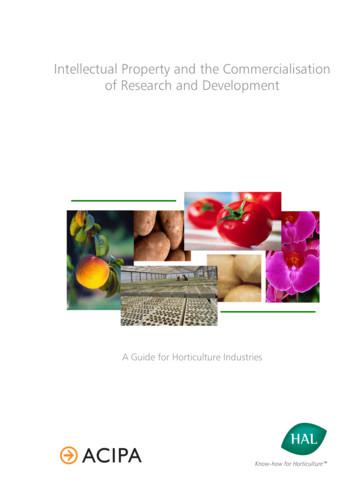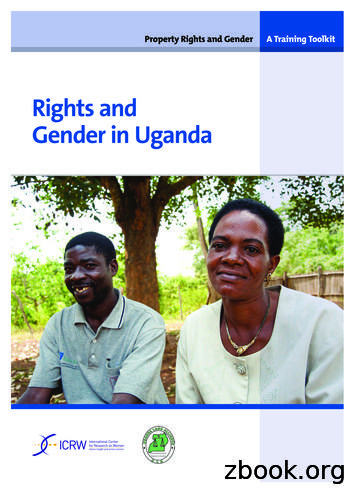Intellectual Property Rights And Clean Energy Technologies
Intellectual property rights andclean energy technologiesAhmed Abdel LatifSenior Programme ManagerInnovation, Technology and Intellectual PropertyICTSDUN Workshop on clean energy technologies29 May 2013International Centre for Trade and Sustainable Developmentwww.ictsd.org
Technology Transfer at the multilateral level since 1992www.ictsd.org
IPRs in Chapter 34 of Agenda 21 (1992) Formulation of policies and programs for the effective transfer ofESTs that are publicly owned or in the public domain; Purchase of patents and licenses on commercial terms for theirtransfer to developing countries on non‐commercial terms, takinginto account the need to protect intellectual property rights; In compliance with and under the specific circumstancesrecognized by the relevant international conventions adhered to byStates, the undertaking of measures to prevent the abuse ofintellectual property rights, including rules with respect to theiracquisition through compulsory licensing, with the provision ofequitable and adequate compensation;www.ictsd.org
IPRs in Rio 20 outcome document (2012)We emphasize the importance of technology transfer to developingcountries and recall the provisions on technology transfer, finance,access to information, and intellectual property rights as agreed inthe Johannesburg Plan of Implementation, in particular its call topromote, facilitate and finance, as appropriate, access to and thedevelopment, transfer and diffusion of ESTs and correspondingknow‐how, in particular to developing countries, on favorableterms, including on concessional and preferential terms, asmutually agreed.www.ictsd.org
The policy debate on IPRs and clean technologieswww.ictsd.org
No need to discussIPRs or considerspecific measuresOpen Expanded use ofInnovationTRIPS flexibilities tofacilitate access toclean technologiesby developingcountriesFacilitating availabilityof IPR relatedinformationViews andProposalson IP and cleantechnologiesExcluding some cleanenergy technologiesfrom patent protectionin developing countriesPatent pools andfunds to finance thetransfer of cleantechnologies todeveloping countriesFacilitating licensingof clean technologiesto developingcountriesFast tracking greenpatent applicationswww.ictsd.org
World Bank, Inclusive Green Growth Report (2012) Suggests the use of compulsory licensing and patent pools tofacilitate access to green technologies. “making it easier for countries to issue compulsory licenses underappropriate circumstances can help ensure more affordable access topatented green innovation by poor households in low incomecountries.”www.ictsd.org
The debate on IP at the UNFCCCConference of theParties (COP)No agreementon mention of IPRssince Bali (2007)TechnologyMechanismTechnology ExecutiveCommitteeClimate TechnologyCentre and NetworkIP an area for which more claritywould be needed(Sept.2012)www.ictsd.org
Untangling the IP and clean energy technology debatewww.ictsd.org
What do international agreements tell usabout the role of IPRs in innovation andtechnology transfer?www.ictsd.org
International IP standards: the TRIPS AgreementArticle 7: objectivesThe protection and enforcement of intellectual propertyrights should contribute to the promotion of technologicalinnovation and to the transfer and dissemination oftechnology, to the mutual advantage of producers and usersof technological knowledge and in a manner conducive tosocial and economic welfare, and to a balance of rights andobligations.www.ictsd.org
International IP standards: the TRIPS AgreementArticle 8: PrinciplesAppropriate measures, provided that they are consistentwith the provisions of this Agreement, may be needed toprevent the abuse of intellectual property rights by rightholders or the resort to practices which unreasonablyrestrain trade or adversely affect the international transferof technology.www.ictsd.org
International IP standards: the TRIPS AgreementArticle 40Members agree that some licensing practices or conditionspertaining to intellectual property rights which restraincompetition may have adverse effects on trade and mayimpede the transfer and dissemination of technology.www.ictsd.org
What does empirical evidence tells us?www.ictsd.org
UNEP‐EPO‐ICTSD Report on Patents and Clean EnergyPeerreviewed byIPCC SDLESIwww.ictsd.org
Increase in clean energy technology patentingPatenting rates in the selected clean energy technologies (CETs) have increasedat roughly 20 per cent per annum since 1997, outpacing traditional energysources of fossil fuels and nuclear energy.
Relative growth rate for selected clean energy technologiesThe fields experiencing the most intensive growth include solar PV, wind, andcarbon capture.
Patenting in clean energy technologiesdominated by OECD countries These six countries account for almost 80 per cent of all patent applicationsin the clean energy technologies, each showing leadership in differentsectors. Concentration of patenting activity in these countries reflects patentingtrends in other technology sectors.
First global licensing survey of clean energy technologies Some 160 entities completed questionnaires returned (50% via online survey) Wide range of responding organisations (multinationals, universities,government agencies)Type of organisationSize
Limited licensing to developing countries'To what extent has your organization entered licensing agreements that involvelicensees (which are not majority‐controlled subsidiaries) based in developing countriesin the last three years?'
BRIC countries important for licensing ‐related activities'With which countries has your organization been most involved in licensing or othercommercialization activities of intellectual property in the field of CETs?'
Factors affecting licensing orco‐operation with developing countries'When your organisation is making a decision whether or not to enter into a licensingor co-operative development agreement with a party in a developing country, to whatextent would the following factors positively affect your assessment?'IPRs are important for the licensing-out of CETs from developped to developing countries,but there are other equally important factors.
Willingness to offer more favourable terms whenlicensing to developing countries'When entering into an out-license agreement with parties that are based in developingcountries, to what extent do the monetary terms of your license reflect your willingness tointroduce greater lenience due to differences in the purchasing power of the parties?'
Fast tracking green patent applications: reduces time to grantOpenInnovationwww.ictsd.org
What about publicly funded research?www.ictsd.org
Challenges and limitations in relation to empirical evidence (1)1) Extraordinary diversity of clean technologieswww.ictsd.org
Challenges and limitations in relation to empirical evidence (2)2) Most patent landscaping studies have been carried out in relation toenergy generation technologies.3) Most empirical evidence focuses on emerging economies, particularlyIndia and China. There is a need for more comprehensive informationabout the needs of technology demandeurs/recipients in developingcountries.4) What type of technology are we looking at? First generation? Secondgeneration?5) Situation fast evolving and role of IP may change with the evolutionof market structure and the increase in patenting of clean technologies.www.ictsd.org
Some developmentsand initiativeswww.ictsd.org
IP, innovation and technology transferIPGreenExchangeOpenInnovation Open(source)EcoPatentCommonsTechnologyDiffusion andTransferInnovationInnovationFast tracking“green” patentapplicationsPracticalMeasuresIPC GreenInventory(WIPO)IncentivesNew cleanenergy patentclassification(EPO)Incentives /LDCs(TRIPS.66.2)LicensingWIPO Green
Lessons from bilateral cooperation on clean technologyOpenInnovationUS China Clean EnergyForumEU‐India Solar EnergycooperationUS‐India Clean EnergyPartnership (PACE)IBSAChina‐India ClimateCooperation Accordwww.ictsd.org
A possible way forwardfor consideration by a future technologyfacilitation mechanismwww.ictsd.org
Agreeing about the importance of the issue (1) Recognition of important role of IPRS in promoting technologicalinnovation. At the same, recognition of the possibility that IPRs may havean adverse impact on the transfer of technologies to developing countries. Recognition that the urgency of addressing many environmentalchallenges requires considering measures in many regulatory areas,including IPRs. Recognition that in many instances the role of IPRs in the transfer of cleanenergy technologies, is often complex as it may vary according totechnology, sector and country and thus makes it difficult to makeabsolute categorisations. Importance of IPRs either should not be over‐estimated orunderestimated. The issue and options to address it should be discussed.www.ictsd.org
Agreeing about how to discuss the issue (2):Elements Based on existing international rights and obligations, whichincludes TRIPS related flexibilitiesBased on empirical evidenceBased on an incremental approach and starting by examining“practical” issues to build trust such as: Improving availability of patent information on green technologies Encouraging licensing of clean energy technologies to developingcountries Patent pools Public private partnerships Use of multilateral financial resources to mitigate costs of licensing insome cases Fast tracking of ‘green patent applications Based on a tailor made approach where specific cases which requiresolutions are examined until consensus builds on the need forfurther international action.www.ictsd.org
Conclusion An international collaborative effort to promote the transfer of cleantechnologies to developing countries which doesn’t address IPRs, may facecredibility issues. At the same time, a balanced approach is needed that seeks to take intoconsideration different viewpoints on the issue taken into considerationthe overall objective of enhancing the diffusion of clean technologies todeveloping countries on an affordable basis. The Rio 20 technology facilitation mechanism could provide a muchneeded comprehensive approach that could offer guidance to currentfragmented efforts to address it.www.ictsd.org
Thank youAhmed Abdel LatifICTSDaabdellatif@ictsd.chwww.ictsd.orgFollow us on Twitter: ICTSDIPFind us on Facebook: Innovation, Technology and IP Programme (ICTSD)www.ictsd.org
on IP and clean technologies Views and Proposals. on IP and clean technologies. Patent pools and funds to finance the transfer of clean technologies to developing countries Patent pools and funds to finance the transfer of clean technologies to developing countries. Excluding some
Article 2. Intellectual Property Intellectual property is work of the human mind through inventions and creations. Article 3 (revised). Definitions The terms as used in this law have the following meanings: 1. Intellectual property rights mean the rights of individuals, legal entities or organizations to their intellectual property; 2.
of intellectual property can deal with those rights. Each of these issues is considered in detail. Enforcing Intellectual Property Rights and Related Issues Having looked at the way in which parties may choose to commercialise their intellectual property rights, Section 6 turns to the management
intellectual property rights constitute private rights of authors or inventors and entitle them to unique rights. For example, an author alone has the right to reproduce, adapt, and publish his works or to grant any permission for the same. The fourth approach is based on the concept that the intellectual property rights
Intellectual Property Rights Prepared by NACEN, RTI, Kanpur Page 2 Take the following Quiz & Test your knowledge Participant is requested to undertake this test as to check his knowledge of Intellectual Property Rights and role of Customs authority in enforcement of these rights at Border.
Intellectual Property Rights, Technology Policies, and Innovation Management, Ankara University is now offering a new graduate degree on intellectual property. Jointly organized by the . Introduction to Intellectual Property and
intellectual property laws that the Eastern District of Virginia is committed to enforcing." "This landmark conviction represents the latest success of ICE in targeting intellectual property thieves," said ICE Director Morton. "Through the National Intellectual Property Rights Coordination Center, ICE will continue
Rights and gendeR in Uganda · 3 Rights & Human Rights Background Rights The law is based on the notion of rights. Community rights workers need to understand what rights are, where rights come from, and their own role in protecting and promoting rights. Community rights worker
type of intellectual creativity, or that are otherwise related to ideas.4 IP rights are rights to intangible things5—to ideas, as expressed (copyrights), or as embodied in a practical implementation (patents). Tom Palmer puts it this way: "Intellectual property rights are rights in ideal objects, which are distinguished from the material .























